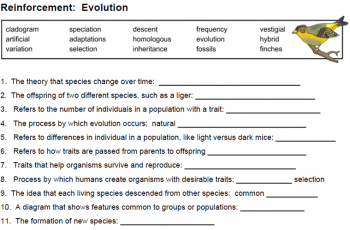Search results for: “apa”
-

Identifying Penguin Species with Restriction Enzymes
In this simple exercise, students simulate how restriction enzymes and gel electrophoresis can be used to identify different species of penguins.
-

Case Study – Tibetans and Altitude (Remote)
This case study is a remote alternative to “How Do Tibetans Survive High Altitudes.” The remove version is shorter and does not require as much guidance by the instructor. I created this version with Google slides, so students can type their answers directly onto the slide. I made remote versions of several activities because I…
-

Speciation on Daphne Major – Big Birds Get No Love
The beaks of finches on the island changed in size after a catastrophic draught. Students analyze graphs and explore how natural selection affects populations.
-

Speciation Modes – Reinforcement
Students distinguish between allopatric and sympatric speciation and then identify what types of isolating mechanisms are described in scenarios.
-

How Can Changes in a Population Lead to New Species?
This lesson explores the two models of speciation: allopatric and sympatric. You can also assign a simple print version that explores speciation modes. Students first read about allopatric speciation and apply it to the finches on the Galapagos islands. Each finch species became isolated on its own island, which resulted in each island having a…
-

Label the Digestive System of a Rabbit
Students in biology may or may not do extensive dissections, but most biology classes do include a unit on comparative anatomy. Many teachers substitute dissections with virtual labs or paper versions of dissections where students label, color, or cut out parts. This worksheet shows a simplified diagram of a human and a rabbit digestive system…
-

Evolution Crossword
This simple worksheet is designed to help students with vocabulary and study for their test over the Theory of Evolution by Natural Selection.
-

Experimental Design
Students in most science classes start with an overview of scientific processes. For advanced students, I use this cheat sheet to remind them of the major features of the scientific method, such as a control group, dependent and independent variables. AP Bio students are also introduced to the concept of the null and alternative hypotheses…
-

Evolution – VIDA chart
This chart is used as a graphic organizer to help students understand the process of evolution by natural selection. I use this chart multiple times throughout the unit, basically for each model organism we study. VIDA means: Variation, Inheritance, Differential Survival and Reproduction, Adaptation. These principles apply not matter what organism you are studying. For…
-

Reinforcement: Evolution
This worksheet was designed for an introductory biology class where students are exposed to basic concepts of biology. The unit covers the history of evolutionary thought (Darwin and the finches of the Galapagos) I focus more on modern examples of evolution, such as rock pocket mice and giraffes. Students match a description or definition to…
-

Anatomy of the Eye (Coloring)
The coloring worksheet is intended to help students learn the location of specific parts of the eye, like the cornea, sclera, lens, and retina.
-

African Elephant – Change Over Time
Students read about how elephant populations declined over a century due to the ivory trade and how international laws attempt to protect elephants. A video shows how female elephants in some areas have evolved the tuskless trait in response to selective pressure from poaching.
-

Penny Lab: Soap and Surface Tension
Most science classes begin the year with an exercise on the scientific method. It can be difficult to plan a short activity that will reinforce the main ideas of developing and testing a hypothesis. This lab is simple and doesn’t require much in the way of materials: pennies, water, and pipettes (and paper towels for…
-

Deer: Predation or Starvation?
This activity asks students to calculate the population change (births – deaths) and then graph the number of deer and the number of wolves.


